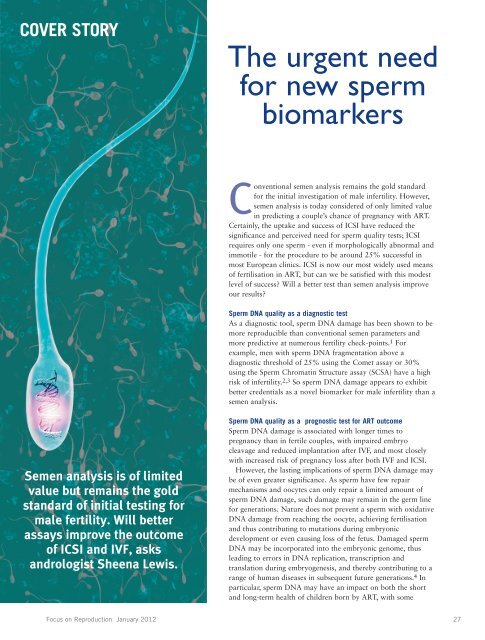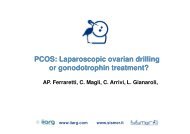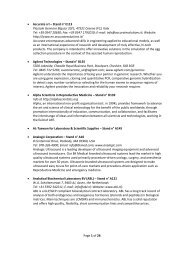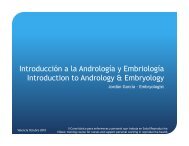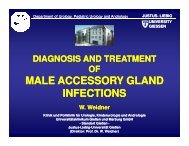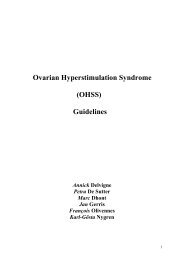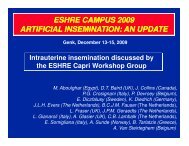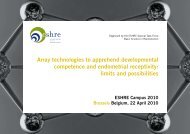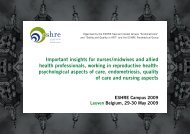TASK FORCES// DEVELOPING COUNTRIES AND INFERTILITY //An expert workshop on the socio-cultural and ethicalaspects of infertility care in poor-resource countriesIn November the Social Science Study Group of the SpecialTask Force held an expert workshop in co-operation withthe Walking Egg Foundation, the University of Amsterdam,Amsterdam Institute for Social Science Research and theWHO. During the two-day meeting, which took place inGenk, specialists from different parts of the worldreviewed the various socio-cultural and ethical aspects ofbiomedical infertility care in poor resource areas. Theseincluded:• Socio-cultural, political and economic barriers to access• Counselling, patient-staff interaction, privacy and otheraspects of care• Ethical concerns at policy and clinical level• Infertility care in times of HIV/AIDSSheryl Vanderpoel from the WHO explained how accessto infertility care would not only help countries reachMillennium Development Goal 5b (‘universal access toreproductive health care’) but would also contribute toMDG 3 (‘gender equality’), MDG 4 (‘neonatal health’),MDG 5 (‘maternal health’), MDG 6 (‘HIV/AIDs’) andMDG 8 (‘new technologies’). Guido Pennings summarisedthe ethical arguments pro and contra infertility treatmentin developing countries.The first session was dedicated to sub-Saharan Africa,and S Dyer and M Patel examined how current out-ofpocketfunding for ART deepens household poverty inSouth Africa. V Horbst and E Mariano explored howpatients in Mali, Togo and Southern Mozambique copewith the barriers to infertility care. And finally, ClausJanisch talked about his own experiences and challenges inoutput-based financing for maternal care in Kenya. The useof vouchers, which are strictly speaking conditional cashtransfers with defined benefits, could be a promisingpayment model for infertility services in poor countries.In the following session D Khalifa (Sudan), H Sallam(Egypt) and S Tremayne (Iran) reviewed socio-cultural,policy and ethical aspects of infertility care in the contextof the Eastern Mediterranean region, defined somewhat byIslamic laws and culture.The next day we turned our attention to the Asianregion. P Nahar concluded after interviewing policymakers,NGOs and donors in Bangladesh that infertility is excludedfrom the public health discourse because of its emphasis onthe epidemiological index, ie, morbidity and mortalityrates. M Pashigian examined the growth of biomedicalservices in Vietnam and the issue of illegal trade intransnational surrogates in Asia.In the next session, we travelled to Bulgaria w<strong>here</strong>,according to Y Panyotova, resource distribution givespriority to expensive treatment for only a minority. Asimilar situation was found by M Makuch in the publichealth sector of Brazil, w<strong>here</strong> the IVF centres do notprovide a service for the most under privileged. Finally, in atalk on cross-border reproductive care, Z Gurtin stressedthe importance of keeping an eye on the broader context oftransnational flows and raised questions on how theprovision of ART in low-resource countries could interact.The final session focused on infertility care in sub-Saharan Africa in times of HIV/AIDs. N Dhont and ABachow explored challenges in the double burden of HIVand infertility for the provision ofinfertility care in developing countries.The final round-table discussionrecognised the multiplicity of barriersto infertility care access and w<strong>here</strong>further research is needed. The nextstep for the group will be thefinalisation of a protocol for theassessment of newly introducedaccessible infertility care in poorresource countries from a socioculturalpoint of view.The Task Force’s workshop on socio-cultural and ethical aspects of biomedical infertilitycare was attended by 27 experts.Nathalie DhontWillem Ombelet, Co-ordinatorTF Developing countries and infertility26 Focus on Reproduction January 2012
COVER STORYThe urgent needfor new spermbiomarkersConventional semen analysis remains the gold standardfor the initial investigation of male infertility. However,semen analysis is today considered of only limited valuein predicting a couple’s chance of pregnancy with ART.Certainly, the uptake and success of ICSI have reduced thesignificance and perceived need for sperm quality tests; ICSIrequires only one sperm - even if morphologically abnormal andimmotile - for the procedure to be around 25% successful inmost European clinics. ICSI is now our most widely used meansof fertilisation in ART, but can we be satisfied with this modestlevel of success? Will a better test than semen analysis improveour results?Sperm DNA quality as a diagnostic testAs a diagnostic tool, sperm DNA damage has been shown to bemore reproducible than conventional semen parameters andmore predictive at numerous fertility check-points. 1 Forexample, men with sperm DNA fragmentation above adiagnostic threshold of 25% using the Comet assay or 30%using the Sperm Chromatin Structure assay (SCSA) have a highrisk of infertility. 2,3 So sperm DNA damage appears to exhibitbetter credentials as a novel biomarker for male infertility than asemen analysis.Semen analysis is of limitedvalue but remains the goldstandard of initial testing formale fertility. Will betterassays improve the outcomeof ICSI and IVF, asksandrologist Sheena Lewis.Sperm DNA quality as a prognostic test for ART outcomeSperm DNA damage is associated with longer times topregnancy than in fertile couples, with impaired embryocleavage and reduced implantation after IVF, and most closelywith increased risk of pregnancy loss after both IVF and ICSI.However, the lasting implications of sperm DNA damage maybe of even greater significance. As sperm have few repairmechanisms and oocytes can only repair a limited amount ofsperm DNA damage, such damage may remain in the germ linefor generations. Nature does not prevent a sperm with oxidativeDNA damage from reaching the oocyte, achieving fertilisationand thus contributing to mutations during embryonicdevelopment or even causing loss of the fetus. Damaged spermDNA may be incorporated into the embryonic genome, thusleading to errors in DNA replication, transcription andtranslation during embryogenesis, and t<strong>here</strong>by contributing to arange of human diseases in subsequent future generations. 4 Inparticular, sperm DNA may have an impact on both the shortand long-term health of children born by ART, with someFocus on Reproduction January 2012 27


